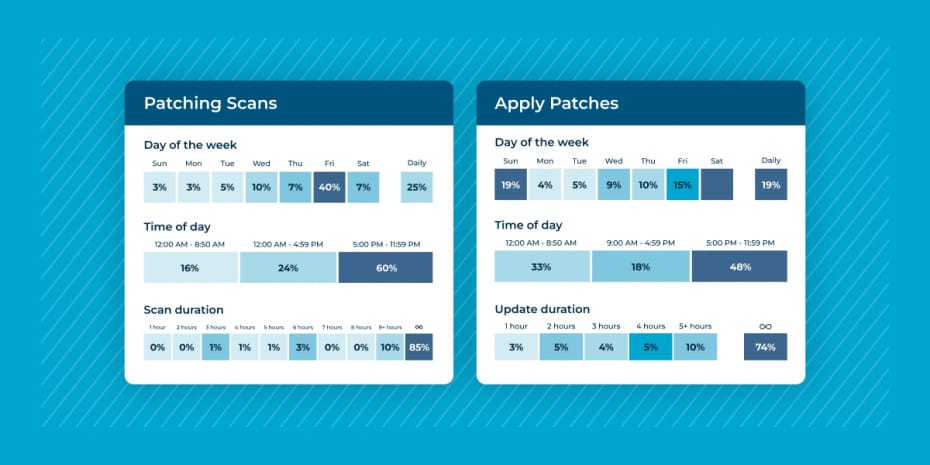As we move into the new year, organizations can expect the number of cyberattacks to increase significantly. In order to battle these upcoming threats, effective patching and patch management processes will be essential. Before patching vulnerabilities, there are two main vulnerability assessments that IT teams should focus on: CVE & CVSS scores. Below, we’ll examine the importance of CVE & CVSS scores along with some of their uses and benefits in the cybersecurity space.
CVE vs CVSS scores
What is CVE score
CVE stands for Common Vulnerabilities or Exposers, and it’s a public list of cybersecurity vulnerabilities. This glossary organizes these security weaknesses with identification numbers, dates, and descriptions.
What is CVSS score
CVSS stands for Common Vulnerability Scoring System, and it’s a numerical score that rates the severity of vulnerabilities on a scale from 0 to 10, with 10 being the most severe. It’s often used to rate the severity of the publicly disclosed vulnerabilities listed in the CVE.
Differences between CVE and CVSS scores
CVE and CVSS ratings are both assessments of vulnerabilities. According to the National Vulnerability Database, a vulnerability is, “A weakness in the computational logic (e.g., code) found in software and hardware components that, when exploited, results in a negative impact to confidentiality, integrity, or availability.” Before patching a vulnerability, organizations will use CVE & CVSS scores to gather more information about the vulnerability and its severity.
Where to find CVE and CVSS scores
Currently, MITRE manages the CVE database and works closely with the National Vulnerability Database (NVD), which is a part of the National Institute of Standards and Technology (NIST). To find CVSS scores, businesses rely on FIRST, a US non-profit organization.
Uses for CVE and CVSS scores
Today, IT teams rely on CVE & CVSS scores to learn more about security weaknesses before creating strategies to solve them. Some common uses for CVE & CVSS scores include:
-
Quantifying the severity of vulnerabilities
CVSS scores quantify the severity of vulnerabilities. An IT team can use this information to determine which vulnerabilities pose the most serious threats and resolve them first before moving on to more minor weaknesses.
For example, a vulnerability with a CVSS score of 8 is more of a threat than a vulnerability with a score of 3. In this case, an IT team can resolve the vulnerability scored 8 first before resolving the less serious vulnerability scored 3.
-
Understanding more about each vulnerability
The CVE provides descriptions, dates, and other information about vulnerabilities. Additionally, the CVE sometimes lists the fixes or solutions for a specific vulnerability. This valuable information allows an IT team to learn more about a vulnerability so that they can come up with a solution.
-
Supporting patch management efforts
CVE & CVSS scores provide guidance for an IT team and additional support for patch management efforts. These assessments help an IT team to plan, prepare, and resolve vulnerabilities before they become serious issues for an organization.
The importance of CVE and CVSS scores
Even though CVE & CVSS scores aren’t perfect, they are currently some of the best assessments to use for vulnerabilities. They allow IT teams to categorize, prioritize, and create order when dealing with pesky vulnerabilities. Additionally, IT teams can rely on both CVE & CVSS scores together to gain more insight into security weaknesses while creating a plan to resolve them.
Limitations of CVE & CVSS scores
Although some organizations claim that CVE & CVSS scores are overused and overvalued in the cybersecurity space, they are currently the best assessments available for vulnerabilities. With that being said, they do have certain limitations as shown below:
CVSS score limitations
-
Inaccurately measures risk
Unfortunately, the CVSS scores given to vulnerabilities don’t always measure risk accurately. For example, vulnerabilities scored 7.0 and above are considered the most serious threats that should be handled before others. However, are threats scored 6.5 any less dangerous than threats scored 7.0? Sometimes, the 6.5 vulnerability ends up causing more issues than a 7.0 vulnerability.
-
Remains unchanged and unupdated
After a CVSS score is assigned to a vulnerability, it is usually never changed or updated. This static score doesn’t take any changes or new information into account.
-
Omits necessary context
Since a CVSS score is simply a number, it does not provide any context or additional information about a vulnerability. Because of this, it’s difficult to determine how a vulnerability will actually affect a security system.
CVE score limitations
-
Lacks critical information
Although the CVE does provide some information about a vulnerability, it does not provide enough for an IT security team to use to fix the issue. Kenna Security explains this issue stating, “CVE records, for instance, generally lack key information such as exploit codes, fixes, popular targets, known malware, remote code execution details, etc. To find those, security personnel have to do some additional sleuthing. (CVE records do often link to vendor sites and other resources, and these may in turn include links to patches and remediation advice. But it’s a manual, hunt-and-peck process that can be overwhelming to security teams facing a list of hundreds, even thousands of so-called critical vulnerabilities.)”
-
Ignores threats for patched software
The CVE only focuses on vulnerabilities in unpatched software, ignoring the risks or threats that target patched software. Just because software is patched does not mean that it’s completely safe from vulnerabilities and threats.
-
Fails to always provide a fix
Although it’s a common belief that the CVE offers fixes for vulnerabilities, that’s not always the case. The CVE sometimes provides solutions or fixes for vulnerabilities, but not 100% of the time.
Strengthen your IT security with NinjaOne
Patching and dealing with vulnerabilities is no easy task. That’s why NinjaOne offers a patch management solution that automates patching processes from a single pane of glass. With NinjaOne, you can minimize costs, reduce complexity, save time, and remediate vulnerabilities quickly. Get in touch with NinjaOne today to learn more and start your free trial.








